Public Viewing Opportunities:
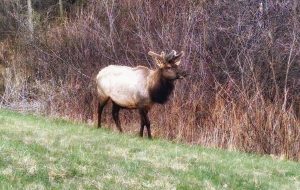 Elk can be seen in many habitats throughout their range. Best viewing times are dawn and dusk. The most popular viewing period is September and October during the mating season when elk are often feeding in openings. Summer observations are possible, but heavy leaf cover makes viewing more difficult.
Elk can be seen in many habitats throughout their range. Best viewing times are dawn and dusk. The most popular viewing period is September and October during the mating season when elk are often feeding in openings. Summer observations are possible, but heavy leaf cover makes viewing more difficult.
It is a good idea to use a National Forest map or county maps to find your way. Road conditions will vary with the season, so drivers should exercise caution before attempting to drive these routes.
Elk can sometimes be viewed along Highway 77 and CTH GG (south to Loretta) in the Clam Lake area (southwest and south of Clam Lake, respectively).
Wildlife viewing areas have been established through a cooperative effort between the Forest Service and RMEF to view many species of wildlife, including elk.
Elk viewing is not confined to the designated areas and routes. Many grassy meadows have been improved for deer, elk and other wildlife that use this type of habitat.
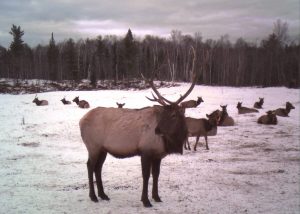 People can disturb elk by approaching too closely. Elk should always be appreciated and viewed from a distance. This will enhance other viewers’ chances to see elk. While searching for elk, always respect the animals and private landowners’ rights and privacy. Whenever you choose to look for elk, plan to set aside some time. Remember these are wild animals. They are on their own schedule, coming and going when and where their needs and desires take them.
People can disturb elk by approaching too closely. Elk should always be appreciated and viewed from a distance. This will enhance other viewers’ chances to see elk. While searching for elk, always respect the animals and private landowners’ rights and privacy. Whenever you choose to look for elk, plan to set aside some time. Remember these are wild animals. They are on their own schedule, coming and going when and where their needs and desires take them.
DNR Elk Brochure: Page 1 & Page 2
History of Elk Project:
Elk (Cervus elaphus), Wisconsin’s largest native mammal, once ranged over most of North America and throughout Wisconsin. They were extirpated in the mid to late 1800’s with the onset of human settlement due to over hunting and a rapid decline in habitat. Elk were last recorded in Wisconsin in the 1886 and historic records show elk once inhabited at least 50 of the state’s 72 counties. An attempt at bringing elk back to the state in the 1930’s failed because of poaching and the last four elk were reportedly killed in 1948. Although elk primarily inhabited the prairie/savannah lands of the southern portion of the state, today, most of the currently suitable elk habitat is in the north. This change is due to the large scale conversion of land in the south from prairie to agriculture.
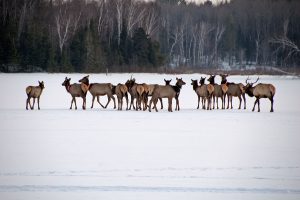 In 1989 the Wisconsin Department of Natural Resources (WDNR) was directed by the State Legislature to explore the likelihood of successfully reintroducing elk, moose, and caribou. The resulting publication “Feasibility Assessment for the Reintroduction of North American Elk, Moose, and Caribou into Wisconsin” (Parker 1990) determined that an elk reintroduction effort could succeed, while reintroductions of moose or caribou likely would not.
In 1989 the Wisconsin Department of Natural Resources (WDNR) was directed by the State Legislature to explore the likelihood of successfully reintroducing elk, moose, and caribou. The resulting publication “Feasibility Assessment for the Reintroduction of North American Elk, Moose, and Caribou into Wisconsin” (Parker 1990) determined that an elk reintroduction effort could succeed, while reintroductions of moose or caribou likely would not.
In 1993 the Wisconsin State Legislature authorized the University of Wisconsin-Stevens Point to evaluate the potential for reintroducing elk to the Great Divide District of the Chequamegon National Forest near Clam Lake. During February 1995, 25 elk were trapped in Michigan, held in a quarantine facility for 90 days while undergoing rigorous disease testing, and shipped to the Clam Lake release site. After being held in a pen for a 2-week acclimation period, the elk were released into the Chequamegon National Forest May 17, 1995.
As noted in Kathryn A. Kahler’s article “A Herd in the Balance”, “the first four years of research on the experimental herd were headed up by the late Dr. Ray Anderson, then a professor at UW-Stevens Point. Anderson and his students oversaw the careful research and methodologies that would form the routines followed by today’s DNR elk project team. Those first few years, with enthusiastic support from thousands of volunteers and benefactors, saw such success that Anderson, in a 1998 research report predicted that “at the current rate of growth, the herd could number approximately 500 in 11 years.”
That optimism has been tempered by a kind of “one step forward, two steps back” reality. Prior to calving, the herd in the spring of 2010 was 131 animals, a far cry from Anderson’s prediction. Even so, there is reason for optimism amid elk enthusiasts of all ilks, some of whom look forward to a year when the population reaches a target goal of 200 animals that might allow a limited bull hunting season.
“We are at least a couple of years away from that,” says Stowell. “Once we get closer we’ll need to establish a hunting education program for successful applicants. An elk that weighs several hundred pounds is much harder to kill than its smaller deer cousin, so we’ll need to educate hunters about elk biology and caution them against shooting at multiple targets if they think the first one didn’t go down.”
Until then Stowell and his crew will continue with the seasonal routines that make up their “elk year” – spring calf-searching, summer habitat improvement, fall bugling observation, winter trapping and year-round telemetry monitoring and mortality tracking.”
Elk Mortality:
Elk are classified as protected, not as an endangered or threatened species in the State of Wisconsin. Since there is no hunting season on elk, it is illegal to shoot an elk. Hunters, especially in the Chequamegon National Forest, need to be able to distinguish an elk from a deer.
The second most common cause of elk death after predation (primarily wolf and bear) is vehicle collision, with over 30 verified deaths since 1995. Six years ago, DNR elk biologists launched a three-pronged effort to prevent elk-vehicle collisions. First, they began using a reflective, blaze orange radio collar on cows to increase their visibility during the dark and dusk periods when most vehicle collisions occur. Second, they moved their winter trapping efforts farther away from state and county highways, drawing elk away from roads during the higher risk period of winter.
Lastly, in December 2006 with the help of volunteers and a grant from the Rocky Mountain Elk Foundation, they installed an elk crossing warning system in three zones at the center of the Clam Lake elk activity area. Each zone is one-half mile wide and two miles long along portions of State Highway 77 where most elk vehicle collisions had been observed. A flashing light on each of the cautionary highway signs is triggered by the elks’ own radio collars when they come within a mile of a receiving station. There are three adjoining receiving station zones spread over six miles of highway where both elk collisions and telemetry have identified high risk areas.
Elk Education Kiosk:
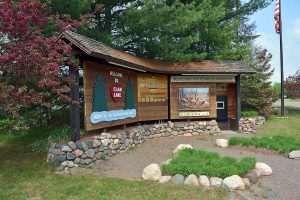
Elk Information Kiosk in the Clam Lake Community Park
An interactive touch screen kiosk was recently retrofitted into an existing sign board located at the junction of State Highways 77 and GG in Clam Lake, Wisconsin. The kiosk is designed to provide visitors to the area with expansive information about the resident elk herd and their habitat. The program provides information about the history of elk in Wisconsin and even has a video clip of the original elk reintroduction.
Most importantly, the program contains other tools and information to help visitors experience elk including wildlife spotting guides, maps and directions to nearby viewing areas. The kiosk was made possible in part by a state grant from the Rocky Mountain Elk Foundation. The kiosk was designed and installed by Imperial Multimedia a Wisconsin-based company that specializes in interpreting nature and the outdoors. This technology was first put to test in Wisconsin State Parks back in 2003 and subsequently has been rolled out across the nation in various venues including state parks, zoos and aquariums.
While Imperial Multimedia did most of the heavy lifting to make the project possible they received invaluable help from the DNR’s Elk Biologists Laine Stowell and Matt McKay along with local help from Bud Rubeck and other local volunteers who donated time and materials to reconstruct the site. This tool should help educate and guide National Forest Visitors to a safe and meaningful experience.
The Elk Information Kiosk can be found in front (or on the east side) of the Clam Lake Junction gas station in Clam Lake Community Park. The Community Park (kiosk) is handicap accessible.
Wisconsin Elk Herd Online:
For more information on Elk in Wisconsin, please contact:
Laine Stowell
WI DNR
10220 State Hwy 27
Hayward, WI 54843
715-634-9658 x 3527
Wisconsin DNR Elk Website
Fall Elk Bugling
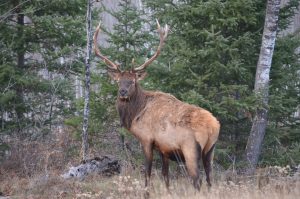 Elk bugling is a special feature of the fall rut usually starting in late August and running through late September in the Clam Lake, Wisconsin area. As the big bull elk prepare to attract female cows, they let out bellows, which range from deep tones to high-pitch squeals to grunts. On fall nights in the Chequamegon National Forest around Clam Lake, Wisconsin, the distinctive sounds of elk rutting can often be heard. Listen to the remarkable, unforgettable sounds of native, free ranging bull elk bugling in a Northern Wisconsin wilderness. If you’ve never heard the bugle of the bull elk during the fall rutting period, you are in for an experience that is at once thrilling and haunting. We invite you to join us in Clam Lake during the month of September and experience this unique event! You won’t soon forget the sounds of elk bulging as they echo through the forest and across the lakes of Northern Wisconsin!
Elk bugling is a special feature of the fall rut usually starting in late August and running through late September in the Clam Lake, Wisconsin area. As the big bull elk prepare to attract female cows, they let out bellows, which range from deep tones to high-pitch squeals to grunts. On fall nights in the Chequamegon National Forest around Clam Lake, Wisconsin, the distinctive sounds of elk rutting can often be heard. Listen to the remarkable, unforgettable sounds of native, free ranging bull elk bugling in a Northern Wisconsin wilderness. If you’ve never heard the bugle of the bull elk during the fall rutting period, you are in for an experience that is at once thrilling and haunting. We invite you to join us in Clam Lake during the month of September and experience this unique event! You won’t soon forget the sounds of elk bulging as they echo through the forest and across the lakes of Northern Wisconsin!
 As of March 2018, the Clam Lake elk herd was estimated to be approximately 185 individuals, with approximately 45 calves expected to be born in spring. This population has grown slowly, but steadily, since reintroduction in 1995.
As of March 2018, the Clam Lake elk herd was estimated to be approximately 185 individuals, with approximately 45 calves expected to be born in spring. This population has grown slowly, but steadily, since reintroduction in 1995.

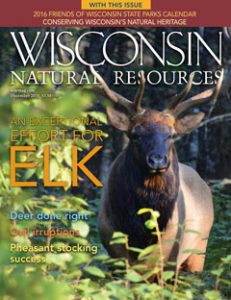
 Elk can be seen in many habitats throughout their range. Best viewing times are dawn and dusk. The most popular viewing period is September and October during the mating season when elk are often feeding in openings. Summer observations are possible, but heavy leaf cover makes viewing more difficult.
Elk can be seen in many habitats throughout their range. Best viewing times are dawn and dusk. The most popular viewing period is September and October during the mating season when elk are often feeding in openings. Summer observations are possible, but heavy leaf cover makes viewing more difficult. People can disturb elk by approaching too closely. Elk should always be appreciated and viewed from a distance. This will enhance other viewers’ chances to see elk. While searching for elk, always respect the animals and private landowners’ rights and privacy. Whenever you choose to look for elk, plan to set aside some time. Remember these are wild animals. They are on their own schedule, coming and going when and where their needs and desires take them.
People can disturb elk by approaching too closely. Elk should always be appreciated and viewed from a distance. This will enhance other viewers’ chances to see elk. While searching for elk, always respect the animals and private landowners’ rights and privacy. Whenever you choose to look for elk, plan to set aside some time. Remember these are wild animals. They are on their own schedule, coming and going when and where their needs and desires take them. In 1989 the Wisconsin Department of Natural Resources (WDNR) was directed by the State Legislature to explore the likelihood of successfully reintroducing elk, moose, and caribou. The resulting publication “Feasibility Assessment for the Reintroduction of North American Elk, Moose, and Caribou into Wisconsin” (Parker 1990) determined that an elk reintroduction effort could succeed, while reintroductions of moose or caribou likely would not.
In 1989 the Wisconsin Department of Natural Resources (WDNR) was directed by the State Legislature to explore the likelihood of successfully reintroducing elk, moose, and caribou. The resulting publication “Feasibility Assessment for the Reintroduction of North American Elk, Moose, and Caribou into Wisconsin” (Parker 1990) determined that an elk reintroduction effort could succeed, while reintroductions of moose or caribou likely would not.
